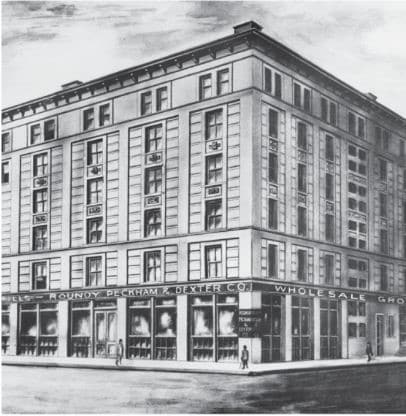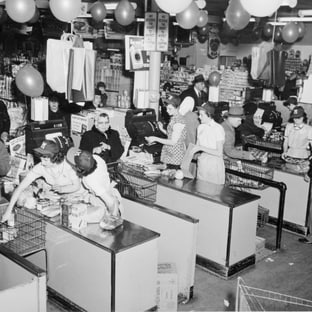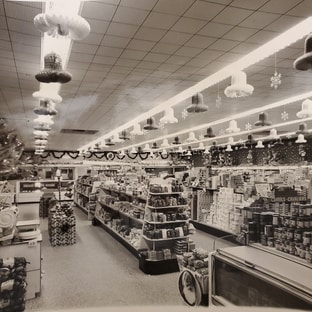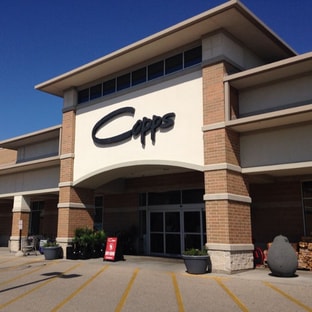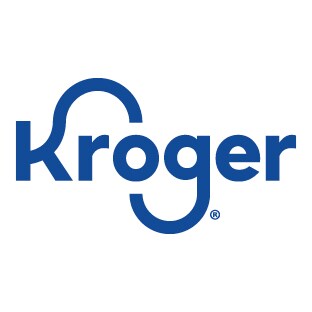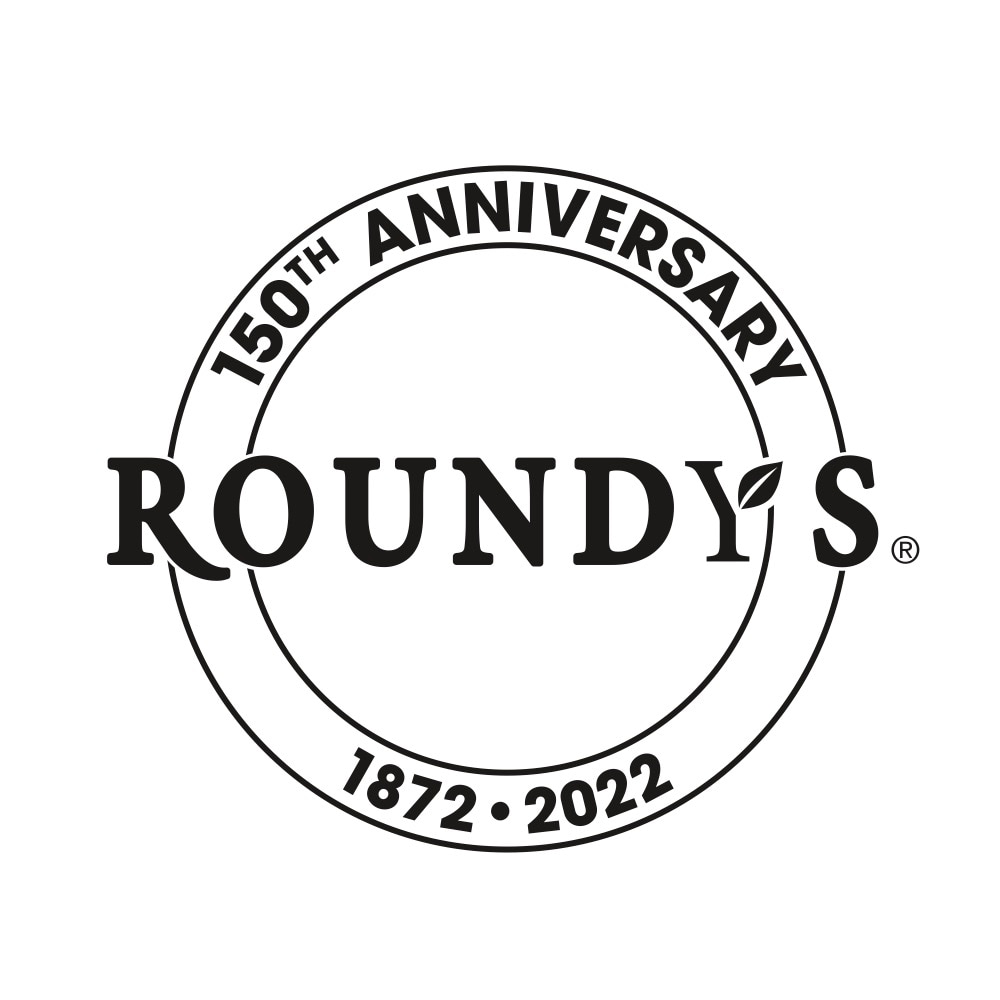The Roundy's Story
Origins of a Wisconsin Institution: 1872-1939
Roundy’s founder, Judson A. Roundy, came to Milwaukee from Rhode Island. In 1872 he and two partners, Sidney Hauxhurst and William E. Smith, founded a wholesale grocery company called Smith, Roundy & Co. Roundy had the food background, Hauxhurst had the legal background and Smith, who later served two terms as Wisconsin’s Governor, had the political connections. Smith, Roundy & Co. soon became one of the largest companies in the West. The company grew out of its first quarters and moved to a larger building at Milwaukee’s Broadway and Buffalo Streets in 1885. This building was destroyed by a famous Milwaukee fire—the 3rd Ward Fire—in 1892. By 1895, the company completed new headquarters at the same location.
Eventually, Smith and Hauxhurst left the venture and he firm took on two new partners, William S. Peckham, and Charles J. Dexter. The company reincorporated in 1902 as Roundy, Peckham & Dexter Co. with Charles Dexter as President. Dexter had been a partner since 1880 and continued as president and chairman until his death in 1939. Dealing in staple and fancy groceries, packaged grains and cereals, roasted peanuts, coffee, and re-packed herring. In 1910 they built an addition to their building to house their new coffee roasting plant and sugar grinding mill. In 1922 salt was added and was the first to bear their private label, Roundy's Salt. The company expanded in the first half of this century until its stockholders numbered about 60, most of whom had inherited their holdings.
Origins of a Wisconsin Institution: 1872-1939
Roundy’s founder, Judson A. Roundy, came to Milwaukee from Rhode Island. In 1872 he and two partners, Sidney Hauxhurst and William E. Smith, founded a wholesale grocery company called Smith, Roundy & Co. Roundy had the food background, Hauxhurst had the legal background and Smith, who later served two terms as Wisconsin’s Governor, had the political connections. Smith, Roundy & Co. soon became one of the largest companies in the West. The company grew out of its first quarters and moved to a larger building at Milwaukee’s Broadway and Buffalo Streets in 1885. This building was destroyed by a famous Milwaukee fire—the 3rd Ward Fire—in 1892. By 1895, the company completed new headquarters at the same location.
Eventually, Smith and Hauxhurst left the venture and he firm took on two new partners, William S. Peckham, and Charles J. Dexter. The company reincorporated in 1902 as Roundy, Peckham & Dexter Co. with Charles Dexter as President. Dexter had been a partner since 1880 and continued as president and chairman until his death in 1939. Dealing in staple and fancy groceries, packaged grains and cereals, roasted peanuts, coffee, and re-packed herring. In 1910 they built an addition to their building to house their new coffee roasting plant and sugar grinding mill. In 1922 salt was added and was the first to bear their private label, Roundy's Salt. The company expanded in the first half of this century until its stockholders numbered about 60, most of whom had inherited their holdings.
Moving Forward as a Grocery Cooperative: 1950s-60s
By 1953 the company was reorganized as Roundy's Inc., a grocery cooperative, and their private label had expanded in every category under the Roundy's Old Time and Mealtime labels. After this change, Roundy’s management set out to offer services to independent grocers that would allow them to compete with large chains. Roundy’s retailer-stockholders were offered bookkeeping and payroll services at low cost, and the company held seminars on grocery-related business topics, such as store security and job training.
Roundy’s opened a grocery distribution center in Wauwatosa, Wisconsin, in 1955, which grew into a 450,000-square-foot complex on ten acres of land. The company began to expand rapidly around this time, becoming one of the largest grocery distributors in Wisconsin. Sales reached $50 million in 1962 and then doubled to $100 million in the next nine years. The huge Wauwatosa warehouse stocked close to 9,700 items, including both Roundy’s private label and national brand foods. Using rail sidings and more than 40 truck loading docks in the early 1970s, the company moved more than 5,000 tons of merchandise a week. The Roundy’s private label had grown to include about 800 items, and sales in 1972 were close to $115 million. As early as 1972, ordering was controlled by computer, and the company’s processing system also was mechanized. Roundy’s believed in using the most modern technology available to run its business and was often at the forefront of grocery innovation, particularly in its landmark warehouse stores.
Moving Forward as a Grocery Cooperative: 1950s-60s
By 1953 the company was reorganized as Roundy's Inc., a grocery cooperative, and their private label had expanded in every category under the Roundy's Old Time and Mealtime labels. After this change, Roundy’s management set out to offer services to independent grocers that would allow them to compete with large chains. Roundy’s retailer-stockholders were offered bookkeeping and payroll services at low cost, and the company held seminars on grocery-related business topics, such as store security and job training.
Roundy’s opened a grocery distribution center in Wauwatosa, Wisconsin, in 1955, which grew into a 450,000-square-foot complex on ten acres of land. The company began to expand rapidly around this time, becoming one of the largest grocery distributors in Wisconsin. Sales reached $50 million in 1962 and then doubled to $100 million in the next nine years. The huge Wauwatosa warehouse stocked close to 9,700 items, including both Roundy’s private label and national brand foods. Using rail sidings and more than 40 truck loading docks in the early 1970s, the company moved more than 5,000 tons of merchandise a week. The Roundy’s private label had grown to include about 800 items, and sales in 1972 were close to $115 million. As early as 1972, ordering was controlled by computer, and the company’s processing system also was mechanized. Roundy’s believed in using the most modern technology available to run its business and was often at the forefront of grocery innovation, particularly in its landmark warehouse stores.
Launching the Pick 'n Save Concept in the 1970s
During the recession that began in 1974, the warehouse stores became important. Roundy’s management detected changing consumer attitudes as the economy worsened and decided to experiment with a new type of store that would appeal to the budget-conscious. Roundy’s rented a vacant discount store in Milwaukee on a short-term lease and opened Pick ’n Save Warehouse Foods in March 1975. The store had minimal decoration and very few perishable items, including no fresh meat and very little produce. The store stood in sharp contrast to the traditional supermarket: packing crates and cases served as the main decor, and untiled floors and plywood walls emphasized the cost-cutting environment. Unique at the time, Pick ’n Save at first drew customers curious to shop in this innovative establishment. Customers used crayons to mark prices on items because the store saved labor by not price-marking, and customers also did their own bagging. The store catered to people doing large-volume shopping. Pick ’n Save became quite popular, and the store at times had long lines of customers waiting to get in. The warehouse concept proved so successful that Roundy’s opened almost 20 more such stores in the next five years, spreading from metropolitan Milwaukee across southern Wisconsin and northern Illinois. Other grocers imitated the warehouse concept as well.
Launching the Pick 'n Save Concept in the 1970s
During the recession that began in 1974, the warehouse stores became important. Roundy’s management detected changing consumer attitudes as the economy worsened and decided to experiment with a new type of store that would appeal to the budget-conscious. Roundy’s rented a vacant discount store in Milwaukee on a short-term lease and opened Pick ’n Save Warehouse Foods in March 1975. The store had minimal decoration and very few perishable items, including no fresh meat and very little produce. The store stood in sharp contrast to the traditional supermarket: packing crates and cases served as the main decor, and untiled floors and plywood walls emphasized the cost-cutting environment. Unique at the time, Pick ’n Save at first drew customers curious to shop in this innovative establishment. Customers used crayons to mark prices on items because the store saved labor by not price-marking, and customers also did their own bagging. The store catered to people doing large-volume shopping. Pick ’n Save became quite popular, and the store at times had long lines of customers waiting to get in. The warehouse concept proved so successful that Roundy’s opened almost 20 more such stores in the next five years, spreading from metropolitan Milwaukee across southern Wisconsin and northern Illinois. Other grocers imitated the warehouse concept as well.
Roundy’s sales expanded in the late 1970s even as the economy pulled out of its slump, proving that the warehouse was not just a fad. The company’s warehouse stores evolved, however, to include more produce and a more finished decor. They began to have brightly painted walls and tiled floors, bringing the look closer to that of the traditional supermarket. But low prices remained the essential difference that set the warehouse stores apart. The stores flourished by moving large volumes of stock, most of which was bought at “deal” prices. Low-priced merchandise coupled with the low overhead and inexpensive fixtures of the warehouse kept prices below those of competitors. Labor costs were also kept in check. To avoid running a labor-intensive fresh meat counter, most stores offered smoked meats only, and stockwork was simple and fast because much merchandise was displayed on pallets at the ends of aisles. Sales per employee hour at Pick ’n Save were said to be almost triple the average at traditional supermarkets, and one Roundy’s executive claimed Pick ’n Save could sell 100 cases of groceries for the same labor cost a traditional store would take to sell only ten. Use of electronic scanner technology also allowed Roundy’s warehouse stores to control costs. Information from scanners was used to determine exactly which brands and sizes sold best, which was crucial for management to know when buying deal merchandise. By keeping costs down, Roundy’s warehouse stores offered consumers consistently low prices, and by 1980 a survey of Milwaukee-area stores found all the company’s major competitors losing market share, while the Roundy’s Pick ’n Save chain gained.
Roundy’s had 27 Pick ’n Save stores in Wisconsin by 1983. With four stores in the Chicago area, Roundy’s strengthened its position in the Chicago market by purchasing Wayco Foods, a suburban grocery. The Wayco acquisition gained Roundy’s a 218,000-square-foot warehouse near Chicago’s O’Hare airport. Now with a base from which to service its Chicago stores, Roundy’s made plans to open 10 to 15 more Pick ’n Saves in the area. This move put Roundy’s in competition with other established warehouse-type chains, such as Cub Foods, owned by Supervalu Inc. of Minnesota.
Rapid Expansion in the 1980s
Roundy’s continued to expand in the 1980s, with somewhat mixed success. Returns on sales began to slip in 1982, and in 1984 and 1985 revenues were stagnant. Profits also fell, and in those two years Roundy’s did not pay rebates (equivalent to stockholder dividends) to its member retailers. The company spent $40 million in 1984 to buy Scot Lad Foods, a grocery distributor in Lansing, Illinois. Although this acquisition doubled corporate sales, it also increased debt. Sales by 1986 were $1.8 billion, coming from the Pick ’n Save chain, wholesale distribution, and stores Roundy’s operated under the names Roundy’s, Shop-Rite, and United Foods. The four Chicago Pick ’n Save stores were not doing well, however, and Roundy’s decided to sell them. Another venture, a gourmet food retailer, also was not doing well. Roundy’s had spent between $1 million and $2.5 million to open the gourmet store, called V. Richards, but the store did not quickly turn a profit.
Roundy’s Chairman and CEO Vincent R. Little, who came up through the ranks of The Kroger Co., took early retirement in 1986 after 12 years at the post. After Little’s exit, the new CEO, John Dickson, appointed two outside directors to Roundy’s board and added two new trustees as well. The new directors and trustees came from outside the grocery business and so brought new perspectives on running a firm as large as Roundy’s. After this management shift, Roundy’s continued to expand through acquisitions. In 1988, the company bought Cardinal Foods Inc., an Ohio-based food distributor, and another Ohio firm, a health and beauty aid distributor called American Merchandising Associates Inc. A year later, Roundy’s spent an undisclosed amount of cash on Viking Foods, Inc. This food distributor, based in Muskegon, Michigan, had 1988 sales of $100 million. That same year, Roundy’s reported a significant increase in sales, which were now up to $2.4 billion.
Early 1990s
As Roundy’s grew, it required more warehouse space to service its retailers. The company leased a new warehouse in Mazomanie, Wisconsin, in 1989, as it ran out of space in its old Wauwatosa facility. Roundy’s grew by more than 20 percent between 1988 and 1991, and warehouse space continued to be at a premium. In April 1992 Roundy’s announced plans to add capacity at its Wauwatosa plant and move some work from a Fort Wayne, Indiana warehouse to its other Wisconsin warehouse in Mazomanie.
By 1994, Roundy’s supplied more than 1,800 grocery stores, with distribution centers in Wisconsin, Illinois, Michigan, Indiana, and Ohio. It’s Pick ’n Save chain continued to grow in the Milwaukee area. Roundy’s had 42 stores in metropolitan Milwaukee in 1994, with a growing market share said to be between 39 and 47 percent. The newest stores were quite different from the original warehouse stores, though Pick ’n Save continued to be distinguished by low prices. Whereas the early stores had no fresh meat and unadorned walls, one newer store boasted an $18,000 imported Italian cappuccino machine in its coffee bar and a reputation as a fine meat market. The stores were tailored to individual neighborhoods and to the owner’s tastes, and, except for sheer size, there was little to tie them to the bare bones warehouses of the 1970s.
Roundy’s suggested in 1994 that it might make a public offering in order to fund future expansion. Then in October 1994, the company announced that it would merge with Spartan Stores, another grocery wholesale cooperative based in Grand Rapids, Michigan. The merger of Roundy’s, the nation’s sixth largest food wholesaler, and Spartan, the seventh largest, would have made the new combined corporation the third largest in the United States. But the merger was called off a month later. The companies announced that they would pursue separate growth strategies, and a Roundy’s vice-president declared that the time was not right for the merger.
In 1995, Roundy’s CEO, John Dickson retired. At the time of his retirement, Roundy’s was the sixth-largest food wholesaler in the U.S. and employed 5,000. In 1994 it earned $6.5 million on sales of $2.46 billion. At that time the cooperative supplied about 1,800 grocery stores in Wisconsin and 11 other Midwestern states. Those included 65 Pick 'n Save stores, eight of which were owned by Roundy's. Gerald (Jerry) F. Lestina succeeded Dickson as President and CEO of Roundy’s.
Retail Expansion: 1995-2003
In 1997, Roundy’s celebrated its 125th anniversary. Having achieved $2.6 billion in sales the preceding year, the company ranked as the largest food corporation in Wisconsin and remained the sixth largest grocery wholesaler in the country. Jerry Lestina seemed intent on staying the course. Although Roundy’s had purchased five Ron and Lloyd’s stores earlier that year, Lestina explained that the purpose of these acquisitions was only to maintain Roundy’s supply chain and its customer base, and that the company would be seeking buyers for these stores. Further, at this time Roundy’s viewed its corporate stores merely as a means of maintaining knowledge of the industry and conducting research and development, rather than as a significant source of revenue. As Lestina told the Post-Crescent on September 29, 1997, “We are primarily wholesalers. It is not our intent to grow our base of corporate stores.”
The 1990s, however, was a decade of rapid consolidation in the grocery industry, and it soon became apparent that Roundy’s would have to adjust its business strategy in order to remain competitive with such industry giants as Minneapolis-based Supervalu or Oklahoma City-based Fleming Companies. Although roughly 90 percent of the company’s revenue came from the wholesale business, the profit margin on these sales was only about 7.5 percent in 1998, and there were few opportunities to substantially increase this percentage. By comparison, the profit margin on retail operations in 1998 was 21 percent.
By 1999, Roundy’s was on a mission to compete with Jewel-Osco, Wal-Mart, Target, and others to become one of Wisconsin’s leading retail supermarket chains. Key to realizing this goal was a flurry of acquisitions. In November 1999, Roundy’s reached an agreement to purchase seven Pick ’n Save stores in eastern Wisconsin—the supermarket assets of Ultra Mart Inc.—whose annual sales topped $150 million. Also that month, Roundy’s announced plans to buy Mega Marts, Inc., the operator of 17 Pick ’n Saves in Wisconsin and Illinois. Together, the deals were expected to increase annual revenue from $2.58 billion to about $3.2 billion.
Roundy’s made another auspicious acquisition in 2001 when it bought Copps Food Centers, then the largest family-owned supermarket chain in Wisconsin, for $95 million. While the Mega Marts and Ultra Mart acquisitions were located mainly in southeastern Wisconsin, the purchase of Copps Corporation’s 21 supermarkets significantly increased Roundy’s presence in central Wisconsin and the Upper Peninsula of Michigan. Moreover, as the Copps stores were already well-run and enjoyed strong brand recognition, Roundy’s was able to take them over, keeping the Copps name, with little additional investment. The acquisition was expected to increase annual sales by more than 20 percent and to bring the retail percentage of the company’s overall sales up to 42 percent. Ultimately, according to Lestina, the company’s goal was to bring retail sales close to 50 percent of overall earnings.
Roundy’s fared very well with these acquisitions, realizing a 15.6 percent increase in sales in 2001, for a total of $3.5 billion. The company’s cooperative, grocer-owned business model was not ideal for its ongoing growth strategy; however, as it did not afford access to the funds needed for major capital investments. In order to finance the $95 million Copps purchase in 1999, for example, Roundy’s had to assemble a $300 million credit agreement with various lenders. To keep pace with the aggressive expansion strategies of its competitors, Roundy’s underwent a major financial restructuring in 2002, whereby the company was acquired by Willis Stein & Partners, a Chicago investment firm. Under the agreement, which was valued at $750 million, Roundy’s retained its independent status as a grocery wholesaler and retailer. Bob Mariano took on leadership of Roundy's Supermarkets Inc. in 2002. Mariano, a grocery industry veteran, was named president and CEO of Dominick's Finer Foods in 1995. He led the company through an initial public offering in 1996 before the company was purchased by Safeway in 1998.
Roundy’s made another auspicious acquisition in 2001 when it bought Copps Food Centers, then the largest family-owned supermarket chain in Wisconsin, for $95 million. While the Mega Marts and Ultra Mart acquisitions were located mainly in southeastern Wisconsin, the purchase of Copps Corporation’s 21 supermarkets significantly increased Roundy’s presence in central Wisconsin and the Upper Peninsula of Michigan. Moreover, as the Copps stores were already well-run and enjoyed strong brand recognition, Roundy’s was able to take them over, keeping the Copps name, with little additional investment. The acquisition was expected to increase annual sales by more than 20 percent and to bring the retail percentage of the company’s overall sales up to 42 percent. Ultimately, according to Lestina, the company’s goal was to bring retail sales close to 50 percent of overall earnings.
Roundy’s fared very well with these acquisitions, realizing a 15.6 percent increase in sales in 2001, for a total of $3.5 billion. The company’s cooperative, grocer-owned business model was not ideal for its ongoing growth strategy; however, as it did not afford access to the funds needed for major capital investments. In order to finance the $95 million Copps purchase in 1999, for example, Roundy’s had to assemble a $300 million credit agreement with various lenders. To keep pace with the aggressive expansion strategies of its competitors, Roundy’s underwent a major financial restructuring in 2002, whereby the company was acquired by Willis Stein & Partners, a Chicago investment firm. Under the agreement, which was valued at $750 million, Roundy’s retained its independent status as a grocery wholesaler and retailer. Bob Mariano took on leadership of Roundy's Supermarkets Inc. in 2002. Mariano, a grocery industry veteran, was named president and CEO of Dominick's Finer Foods in 1995. He led the company through an initial public offering in 1996 before the company was purchased by Safeway in 1998.
With new access to investor capital, growth objectives included ongoing expansion of the retail business through the introduction of new product lines and through further acquisitions. A major example of the latter occurred in May 2003, when Roundy’s announced plans to purchase 31 Rainbow Foods stores—all but one located in the Minneapolis-St. Paul metropolitan area—from Fleming Companies, Inc. in a deal worth nearly $120 million. With a proven record of success, Roundy’s appeared well positioned to maintain its competitive edge in the industry.
Mariano's Launch
The Mariano’s story began in 2010 when Robert A. “Bob” Mariano, then President of Roundy’s, saw a disparity with Chicagoland grocery shoppers’ interactions with their local grocers. Shoppers were becoming more detached from their food shopping experience and Bob conceptualized the need for a more meaningful “interactive” approach to grocery shopping.
After embarking on market studies and drawing upon decades of his own and his management team’s grocery expertise, the Mariano’s experience was created with the first store opening in July of 2010 in Arlington Heights, Illinois.
Roundy's Goes Public
On February 8, 2012, Roundy’s goes public as trading on the New York Stock Exchange begins under the ticker symbol RNDY. The stock ends its first day of trading with a closing price of $11.82.
Dominick's Store Acquisitions
In October of 2013, Safeway Inc., the owner of Dominick's Finer Foods, announced that it's exiting the Chicago market by early 2014. On December 2, 2013, Roundy’s announced it paid $36 million in cash to Safeway Inc. to take over 11 local Dominick's grocery stores, with the intention of converting them to Mariano’s stores.
Mariano's Launch
The Mariano’s story began in 2010 when Robert A. “Bob” Mariano, then President of Roundy’s, saw a disparity with Chicagoland grocery shoppers’ interactions with their local grocers. Shoppers were becoming more detached from their food shopping experience and Bob conceptualized the need for a more meaningful “interactive” approach to grocery shopping.
After embarking on market studies and drawing upon decades of his own and his management team’s grocery expertise, the Mariano’s experience was created with the first store opening in July of 2010 in Arlington Heights, Illinois.
Roundy's Goes Public
On February 8, 2012, Roundy’s goes public as trading on the New York Stock Exchange begins under the ticker symbol RNDY. The stock ends its first day of trading with a closing price of $11.82.
Dominick's Store Acquisitions
In October of 2013, Safeway Inc., the owner of Dominick's Finer Foods, announced that it's exiting the Chicago market by early 2014. On December 2, 2013, Roundy’s announced it paid $36 million in cash to Safeway Inc. to take over 11 local Dominick's grocery stores, with the intention of converting them to Mariano’s stores.
Roundy's Exits Twin Cities
In May 2014, Roundy’s announces its exit from the Twin Cities Market. Roundy’s had purchased 31 Rainbow Foods stores from Fleming Companies in 2003.
The Merger: 2015
The Kroger Co and Roundy's Inc. ink a definitive merger deal, through which the joint company will operate 2,774 supermarkets and employ more than 422,000 associates across 35 states and the District of Columbia.
Through the agreement, Kroger purchased all outstanding shares of Roundy's for $3.60 per share in cash, or $800 million. The merger deal closed in December of 2015 and The Kroger Co. added 151 new stores to its nationwide network blending Roundy's complementary markets with Kroger's strengths in scale and merchandising.
Post-Merger
In March 2016, The Kroger Co. names Michael Marx, VP of People Operations for Kroger, to serve as president of Roundy's Supermarket, Wisconsin. Don Rosanova, who had been EVP of operations at Roundy’s since 2006, was named President of Mariano's with both reporting to Roundy's CEO Bob Mariano. On September 1, 2016, Bob Mariano, the Roundy's CEO who launched the fast-growing Mariano's grocery chain in the Chicago area before negotiating the sale of Roundy's to Kroger retires. In September 2018, Don Rosanova retires. The Kroger Co. then combines the Mariano’s banner with Roundy’s Wisconsin banners to form the Roundy’s Division, based in Milwaukee, WI under the leadership of Roundy’s President, Michael Marx.
The Kroger Co. makes a substantial capital investment in Roundy’s Wisconsin and Illinois markets. Roundy’s benefits tremendously from these investments by investing in store remodels, resets, merchandising, technology, pricing, people, and fresh and friendly redefining the food and grocery customer experience in the markets Roundy’s serves.
The Merger: 2015
The Kroger Co and Roundy's Inc. ink a definitive merger deal, through which the joint company will operate 2,774 supermarkets and employ more than 422,000 associates across 35 states and the District of Columbia.
Through the agreement, Kroger purchased all outstanding shares of Roundy's for $3.60 per share in cash, or $800 million. The merger deal closed in December of 2015 and The Kroger Co. added 151 new stores to its nationwide network blending Roundy's complementary markets with Kroger's strengths in scale and merchandising.
Post-Merger
In March 2016, The Kroger Co. names Michael Marx, VP of People Operations for Kroger, to serve as president of Roundy's Supermarket, Wisconsin. Don Rosanova, who had been EVP of operations at Roundy’s since 2006, was named President of Mariano's with both reporting to Roundy's CEO Bob Mariano. On September 1, 2016, Bob Mariano, the Roundy's CEO who launched the fast-growing Mariano's grocery chain in the Chicago area before negotiating the sale of Roundy's to Kroger retires. In September 2018, Don Rosanova retires. The Kroger Co. then combines the Mariano’s banner with Roundy’s Wisconsin banners to form the Roundy’s Division, based in Milwaukee, WI under the leadership of Roundy’s President, Michael Marx.
The Kroger Co. makes a substantial capital investment in Roundy’s Wisconsin and Illinois markets. Roundy’s benefits tremendously from these investments by investing in store remodels, resets, merchandising, technology, pricing, people, and fresh and friendly redefining the food and grocery customer experience in the markets Roundy’s serves.
150-Year Anniversary
Roundy’s celebrates its 150th Anniversary in 2022. Today, Roundy’s has 150 store locations: 106 stores in Wisconsin under the Pick ‘n Save and Metro Market Banners and 44 Illinois stores under the Mariano’s banner. The Kroger Co. also operates two distribution centers located in Wisconsin including a 1.1 million square foot, state-of-the-art distribution center in Oconomowoc WI. The Kroger Co. also operates a multi-purpose food production manufacturing plant in Kenosha, Wisconsin. Roundy’s has approximately 12,500 associates located throughout the state of Wisconsin, making it one of the largest employers in the state.
Roundy’s is committed to help end hunger and eliminate waste in the communities it serves through Kroger’s Zero Hunger|Zero Waste social action plan. Roundy’s is guided by its values and Purpose: Feed the Human Spirit™.
150-Year Anniversary
Roundy’s celebrates its 150th Anniversary in 2022. Today, Roundy’s has 150 store locations: 106 stores in Wisconsin under the Pick ‘n Save and Metro Market Banners and 44 Illinois stores under the Mariano’s banner. The Kroger Co. also operates two distribution centers located in Wisconsin including a 1.1 million square foot, state-of-the-art distribution center in Oconomowoc WI. The Kroger Co. also operates a multi-purpose food production manufacturing plant in Kenosha, Wisconsin. Roundy’s has approximately 12,500 associates located throughout the state of Wisconsin, making it one of the largest employers in the state.
Roundy’s is committed to help end hunger and eliminate waste in the communities it serves through Kroger’s Zero Hunger|Zero Waste social action plan. Roundy’s is guided by its values and Purpose: Feed the Human Spirit™.

